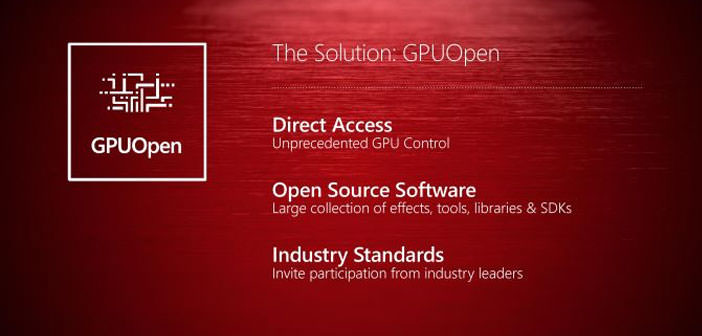AMD’s answer to NVIDIA GameWorks with GPUOpen, where ” open ” is going to open-source. As Mantle before her, it is a suite of tools that will allow game developers to take advantage of the resources provided by the GPU.
Facilitate the development of cross-platform and deliver to developers the tools to create the best possible conditions the port from console to PC. Together with the need to break down the barriers to entry to affect, tools, libraries and SDK, are the two key assumptions on which AMD based GPUOpen, the new suite of tools completely open source.
AMD, which holds about 20% market share in the PC and 100% in the console, then responds with NVIDIA to offer diametrically opposed against hardship and setting a platform closed imposed by GameWorks, terraced platform completely open, as the name suggests.
Via an internet portal any developer can consult the software developed by engineers from AMD and decide freely to implement within their game. TressFX 3.0, GeometryFX, AOFX, ShadowFX, LiquidVR SDK, sample code in DirectX 11 and 12 and other types of SDK will be made available through this handset under the very permissive MIT License. And everything will be issued in parallel on GitHub from January 2016.
With GPUOpen, AMD continues on the road before you draw with Mantle, ie, he wants to make available to developers as many resources as possible to the GPU, allowing them to work directly with the hardware, and then removing the layers of metal and software that you can remove.
AMD’s answer to NVIDIA CUDA concerns also, through the initiative known as Boltzmann Initiative. Which it does not imply that the CUDA GPU AMD can execute code, but that code from CUDA will be possible for developers to quickly get compliant code through automatic conversions. Thanks to a new set of Linux drivers type headless also implement support for AMD’s Heterogeneous System Architecture for its discrete video cards and not only for the APU.
Just the more layered support in Linux is the other part of the new strategy supported by AMD GPUOpen. AMD is working to make it immediate access to the products and features so that the debut of the new hardware is already guaranteed a broader support to Linux distributions. All in view also of the imminent ascent of Linux in the field of gaming, from the new Steam Machine.
AMD lags behind NVIDIA regarding the optimization of its drivers for Linux, but with AMDGPU wants to rethink its approach to Linux. It is a kernel driver that supports all basic video solutions produced by AMD in 2015, both for the professional sector that those addressed to consumers. With AMDGPU it is produced two versions of the driver, an open source and the other partially closed source. In the first case the approach of AMD will keep the driver constantly updated whenever there are changes to the Linux kernel and clearly will marry particularly well with those distros that are completely open source. The second variant is the successor to the driver Catalyst/fglrx and allow you to interact with those components of the driver typically closed source such as OpenCL runtime and multimedia.
Ultimately, AMD has chosen to focus sharply on the open-source approach to counter the closed pursued by NVIDIA with GameWorks. Several times, its engineers had criticized GameWorks, arguing that prevented AMD access to the codes of the game aiming to optimize their instruments and improve the performance of video cards Radeon. On the eve of the market debut of the first games based on DirectX 12 and the finalized version of Vulkan, GPUOpen could become a landmark for the community of developers who are eager to work together to find answers to the problems from which AMD started.

